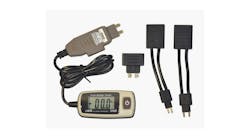If you perform brake work, squeal problems are something you’d like to avoid at any cost. Although brake squeal causes more brake-job comebacks than any other type of service, you can prevent most of them if you recognize the major causes. Here’s a countdown of the top 10 brake-squeal factors. Get to know them well; your reputation rides on it.
Missing/damaged disc pad insulators
Even with a securely mounted pad, squeal can result without a good insulator shim. It’s especially important on imports, because both inboard and outboard pads may use an insulator shim. Check the pad closely to make sure it’s insulated properly. If the shim looks damaged in any way or is missing, install a new one.
Loose pad-to-caliper fit
A loose outer pad can vibrate at high frequency against the caliper housing, producing brake squeal. Although measures to ensure a snug outer pad are no secret, there are several ways to get the job done. Since methods can vary for the same manufacturer because of different calipers, the best thing to do is follow the procedure that applies to the brake system you’re working on.
Rusty, burred or worn caliper slides
This results from a lack of lubrication between the caliper and the caliper mounting. On vehicles that get a liberal seasoning of salt during winter, this lubrication is even more crucial. Follow the manufacturer’s recommendations for lubricating the caliper mounting slides. Since you don’t routinely repack front bearings on front-wheel-drive cars, make sure to periodically clean and lubricate the slides and hardware.
Rotor/drum defects
Roughness, scoring, hot spots, out-of-square, out-of-round or bell-mouth conditions are the things to look for. Scoring occurs when sand or grit gets between the lining and the rotor or drum, when the lining is of poor quality or has excessive wear. Before machining rotors and drums, make sure the lathe’s cutting bits are sharp. Check the lathe’s cutting depth, speed and feed for proper setting. Use a dampening device during machining to prevent a chatter-related rough finish. After machining, use a lathe swirl grinder or sand in a circular motion with a piece of No. 120 emery cloth.
Improper drum/shoe contact
Lining pinch is one of the most frequent causes of squeal on drum brakes. This occurs when the heel and toe of the shoe push against the drum, but the center doesn’t. Today, most brake shoes come with lining that has an eccentric grind, rather than a concentric grind, right off the shelf. This means the lining is thickest at the middle of the shoe and tapers towards the heel and toe. Eventually, the lining will wear in and match the diameter of the drum.
Defective lining
Look for wear, grease, glazing, dirt and loose rivets or bonding. If there are signs of damage, replace the shoes or pads in axle sets. On some vehicles, brake squeal may be loudest when the brakes are applied for the first time in the morning from lining that absorbs moisture overnight. If your inspection reveals little in the way of problems, check and see if a service bulletin addresses the issue. Lining replacement may be the only cure.
Faulty return springs or retaining hardware
Look for missing or damaged anti-rattle and anti-squeal hardware on disc brakes. On drum brakes, check the hold-down hardware and return springs. Always replace the springs and hardware when doing a brake job.
Damaged backing plate
Check the backing plate to make sure it’s tight and straight. A bent backing plate changes the working relationship between the shoes and the drum. Inspect the shoe support bosses on the backing plate for grooves and proper lubrication. The bosses should have no wear grooves, and each boss should have lubricant on it. If the bosses have grooves, replace the backing plate. Use a high-temperature brake lube on the bosses.
Deformed brake shoes
Reputable brake manufacturers go through costly, painstaking processes to make sure their brake shoes are OK, but there’s always the possibility of shoe damage during shipping and handling. If the lining looks like it has the proper eccentric grind, look down the ends of the shoes while holding something known to be square against the spot where the webbing joins the metal backing for the lining. Check both ends and both sides of each shoe. If the webbing-to-backing junction isn’t square, don’t put the shoes on the car. Use another set.
Missing dampening spring
Some brake drums have a spring wrapped around the outside to dampen some of the vibrations that cause squeal. This spring looks a lot like those used on screen doors. Don’t rely on comparing the other drum to see if its spring is in place. It could be missing from the other side as well. Check a shop manual to be sure.
Keep the Top 10 in mind during all of your brake work. You definitely don’t want these as your favorite hits. Remember, silence is golden.

